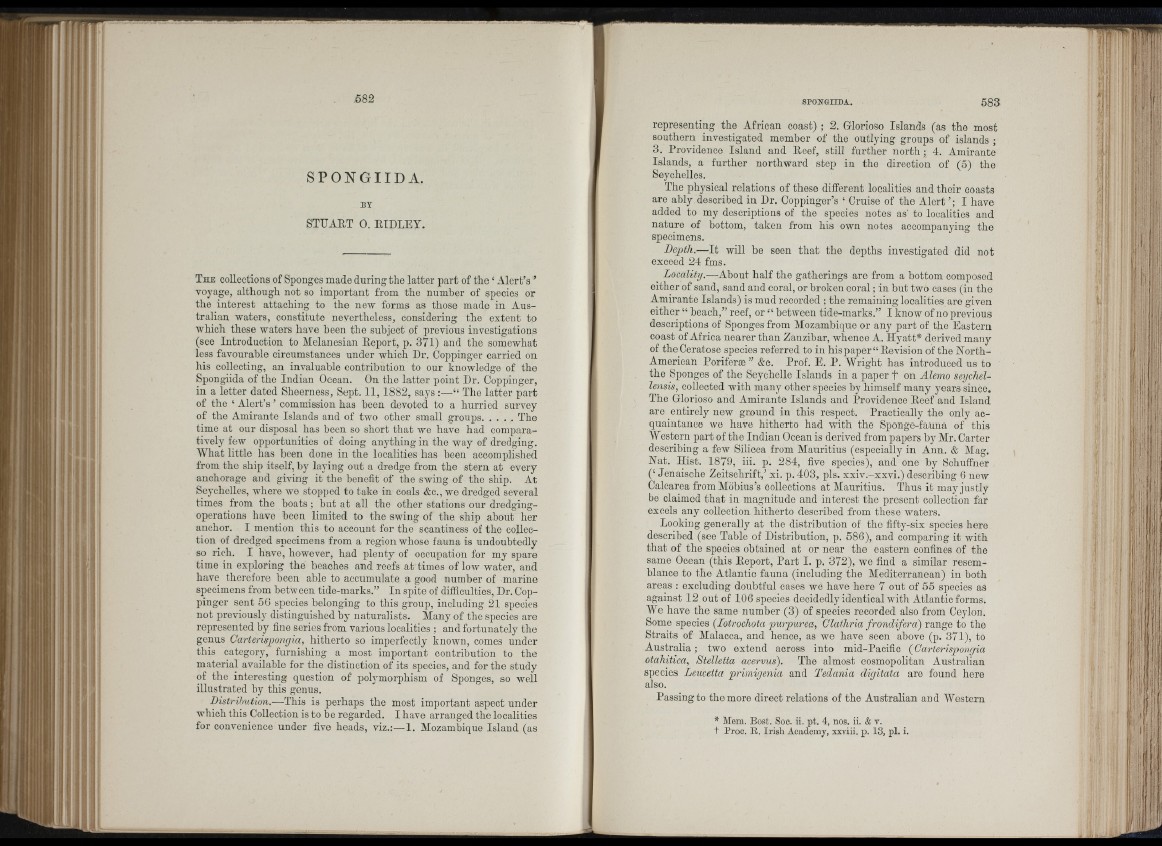
S PO NG I ID A .
BY
STUAET 0 . EIDLEY.
T h e collections of Sponges made during the latter part of the ‘ Alert’s ’
voyage, although not so important from the number of species or
the interest attaching to the new forms as those made in Australian
waters, constitute nevertheless, considering tbe extent to
wbicb these waters bave been tbe subject of previous investigations
(see Introduction to Melanesian Eeport, p. 371) and the somewhat
less favourable circumstances under which Dr. Coppinger carried on
his collecting, an invaluable contribution to our knowledge of tbe
Spongiida of tbe Indian Ocean. On tbe latter point Dr. Coppinger,
in a letter dated Sbeerness, Sept. 11, 1882, says :—“ Tho latter part
of the ‘ Alert’s ’ commission bas been devoted to a hurried survey
of tbe Amirante Islands and of two otber small groups Tbe
time at our disposal bas been so short th at we have had comparatively
few opportunities of doing anything in the way of dredging.
Wbat little has been done in tbe localities bas been accomplished
from tbe ship itself, by laying out a dredge from the stern at every
anchorage and giving it the benefit of the swing of tho ship. At
Seychelles, where we stopped to take in coals &c., we dredged several
times from the b o a ts ; but a t all the otber stations our dredging-
operations have been limited to the swing of the ship about her
anchor. I mention this to account for the scantiness of the collection
of dredged specimens from a region whose fauna is undoubtedly
so rich. I have, however, bad plenty of occupation for my spare
time in exploring the beaches and reefs a t times of low water, and
bave therefore been able to accumulate a good number of marine
specimens from between tide-marks.” In spite of difficulties, Dr. Coppinger
sent 5G species belonging to this group, including 21 species
not previously distinguisbed by naturalists. Many of the species are
represented by fine series from various localities : and fortunately the
genus Carterispongia, hitherto so imperfectly known, comes under
this category, furnishing a most important contribution to the
material available for the distinction of its species, and for tbe study
of the interesting question of polymorphism of Sponges, so well
illustrated by tbis genus.
Distrihution.—This is perhaps the most important aspect under
which this Collection is to be regarded. I have arranged tbe localities
for convenience under fivo beads, viz.:—1, Mozambique Island (as
representing tbe African coast) ; 2. Glorioso Islands (as the most
southern investigated member of tbe outlying groups of islands ;
3. Providence Island and Eeef, still farther n o r th ; 4. Amirante
Islands, a further northward step in the direction of (5) the
Seychelles.
Tbe physical relations of these different localities and their coasts
arc ably described in Dr. Coppinger’s ‘ Cruise of tbe Alert ’; I have
added to my descriptions of tbe species notes as' to localities and
nature of bottom, taken from bis own notes accompanying tbe
specimens.
Depth.— I t will be seen th a t tbe depths investigated did not
exceed 24 fms.
Locality.—About half the gatherings are from a bottom composed
either of sand, sand and coral, or broken coral; in but two cases (iu the
Amirante Islands) is mud recorded ; tbe remaining localities are given
either “ beach,” reef, or “ between tide-marks.” I know of no previous
descriptions of Sponges from Mozambique or any part of tbe Eastern
coast of Africa nearer than Zanzibar, whence A. Hyatt* derived many
of tbe Ceratose species referred to in his paper “ Eevision of tbe Nortb-
American Poriferae ” &c. Prof. E. P. Wright has introduced us to
tbe Sponges of the Seychelle Islands in a paper t on Alemo seychel-
lensis, collected with many otber species by himself many years since.
Tbe Glorioso and Amirante Islands and Providence Eeef and Island
are entirely new ground iu tbis respect. Practically the only acquaintance
we bave hitherto had witb tbe Sponge-fauna of this
Western part of tbe Indian Ocean is derived from papers by Mr. Carter
describing a few Silicea from Manritius (especially in Ann. & Mag.
Nat. Hist. 1879, iii. p. 284, five species), and one by Scbuffner
(‘ Jenaische Zeitscbrift,’ xi. p. 403, pis. xxiv.-xxvi.) describing 6 new
Calcarea from Mobius’s collections at Mauritius. Thus it mayjustly
be claimed th a t in magnitude and interest tbe present collection far
excels any collection hitherto described from these waters.
Looking generally at tho distribution of tbe fifty-six species here
described (see Table of Distribution, p. 586), and comparing it witb
th at of the species obtained a t or near tbe eastern confines of the
same Ocean (tbis Eeport, P a rt I. p. 372), we find a similar resemblance
to the Atlantic fauna (including the Mediterranean) in both
areas : excluding doubtful eases we bave here 7 out of 55 species as
against 12 out of 106 species decidedly identical with Atlantic forms.
We have the same number (3) of species recorded also from Ceylon.
Some species {lotrochota purpurea, Clathria frondifera) range to the
Straits of Malacca, and hence, as we bave seen above (p. 371), to
Australia; two extend across into mid-Pacific {Carterispongia
otahitica, Stelletta acervus). The almost cosmopolitan Australian
species Leucetta primigenia and Tedania digitata are found here
also.
Passing to tbe more direct relations of tbe Australian and AYestern
* Mem. Bost. Soc. ii. pt. 4, nos. ii. & v.
t Proc. R. Irish Academy, xxviii. p. 13, pi. i.
;!i\ r l
ft*